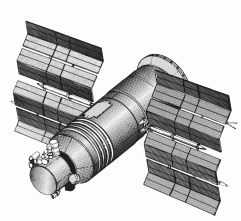|
|
Gamma

The Gamma observatory was a Soviet-based spacecraft launched on 11 July
1990. The satellite was in an orbit of ~ 375 km altitude, 51.6 degrees
inclination. Gamma offered the possibility of locating COS-B sources with
a precision of a few arcminutes. The mission lasted ~ 2 years.
The science instrumentation included the Gamma-1 telescope (with a
Telezvezda star tracker), the Disk-M telescope, and the Pulsar X-2
telescope. All 3 instruments were mounted coaxially on the observatory,
allowing for simultaneous observation of any given region of the celestial
sphere.
The Gamma-1 telescope was the principle instrument aboard the Gamma
observatory. It was designed to perform detailed studies in the
energy range 50 MeV - 6 GeV. The system consisted of 2 scintillation
counters and a gas Cerenkov counter. It had an effective area of ~2000 sq-cm.
Its angular resolution at 100 MeV was 1.5 degrees. The imaging field of view
was +/- 2.5 degrees. The energy resolution was 12% at 100 MeV. Rather late in
the game, it was decided to include a tungsten coded aperture
mask which could be moved in and out of the field of view. The mask itself was
made of 2 1-D masks each having a unit cell size of 1 mm. The basic
resolution achieved by the mask was ~20 arcminutes for the weakest sources
(4-sigma). Shortly after launch, the power to the spark chamber failed.
This resulted in the angular resolution for most of the mission being
only ~ 10 degrees. The telescope was a joint Soviet-French endeavor.
The Telezvezda star tracker worked together with the Gamma-1 telescope. It
had a 6 deg x 6 deg field of view, and a 5th stellar magnitude sensitivity.
It had an angular resolution of 2 arcmin, making it possible to determine
the Gamma-1 pointing direction to the same accuracy.
The Disk-M telescope was designed to measure fluxes in the range 20 keV - 5
MeV. The detector consisted of NaI scintillation crystals. The angular
resolution of the telescope was ~ 25 arcmin. The Disk-M telescope stopped
working not long after launch.
The Pulsar X-2 telescope covered 2-25 keV with ~ 30 arcmin resolution and a
10 deg x 10 deg field of view. The telescope was a joint Soviet-French
endeavor.
Studies were made of the Vela pulsar, the galactic center region, the Cygnus
binaries, the Heming gamma source in Taurus, and Her X-1. The observatory also
gathered information about the high-energy emissions of the Sun during peak
solar activity.
- Ramsden 1983, Adv Sp Res, 3,#4, pp.31-38.
- Akimov et al. 1991, Astronomicheskiy Zhurnal, 17, #6, pp.501-504.
- Polezhayev and Poluektov 1991, Zemlya I Vselennaya, #3,
pp. 2-9.
[Gallery]
[All Missions]
[by Time]
[by Energy]
Page authors: Lorella Angelini Jesse Allen
HEASARC Home |
Observatories |
Archive |
Calibration |
Software |
Tools |
Students/Teachers/Public
Last modified: Thursday, 26-Jun-2003 13:48:16 EDT
|


